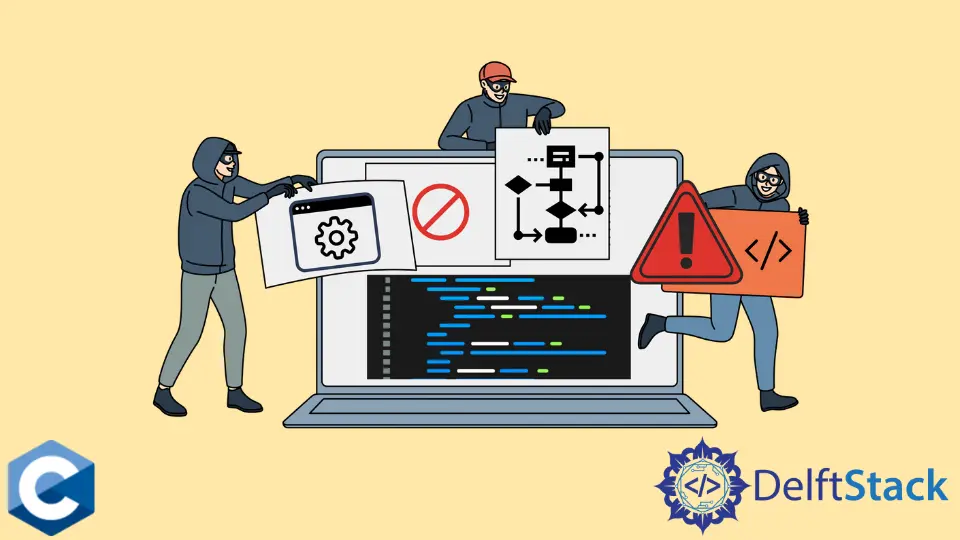在 C 語言中殺死一個子程序
Jinku Hu
2023年10月12日

本文將演示有關如何在 C 語言中殺死子程序的多種方法。
使用 SIGKILL 訊號終止 C 語言中的子程序
有多種訊號設計用於在程序交付時終止該程序,但是傳送 SIGKILL 訊號是執行此任務的最強大,最可靠的方法。通常,程式可以註冊稱為訊號處理程式的特殊功能,一旦將相應的訊號傳遞到程式,這些特殊功能便會自動呼叫。使用者實現處理程式功能程式碼,該程式碼通常會對程式進行一些清理工作。除函式處理程式外,對傳遞的訊號可能有預設操作,例如阻塞和忽略。雖然,給定功能不能忽略,阻止或處理 SIGKILL 訊號。因此,在嘗試終止程序時,此方法應該是最後的選擇。
可以通過 kill 系統呼叫來傳送 SIGKILL 訊號。但是請注意,在以下程式碼示例中註冊的 SIGTERM 處理程式無法捕獲提供的 SIGKILL,它會立即終止給定的子程序。
以下程式產生一個子程序,並在其中註冊 SIGTERM 處理程式。然後,除非傳遞訊號,否則子程序將執行無限迴圈,這將翻轉 while 表示式變數。因此,父級傳遞的 SIGKILL 訊號不會呼叫處理程式並立即終止子級程序。
#include <signal.h>
#include <stdio.h>
#include <stdlib.h>
#include <string.h>
#include <sys/wait.h>
#include <unistd.h>
volatile sig_atomic_t shutdown_flag = 1;
void cleanupRoutine(int signal_number) { shutdown_flag = 0; }
int main(void) {
int wstatus;
pid_t c_pid = fork();
if (c_pid == -1) {
perror("fork");
exit(EXIT_FAILURE);
}
if (c_pid == 0) {
printf("printed from child process - %d\n", getpid());
int count = 0;
struct sigaction sigterm_action;
memset(&sigterm_action, 0, sizeof(sigterm_action));
sigterm_action.sa_handler = &cleanupRoutine;
sigterm_action.sa_flags = 0;
// Mask other signals from interrupting SIGTERM handler
if (sigfillset(&sigterm_action.sa_mask) != 0) {
perror("sigfillset");
exit(EXIT_FAILURE);
}
// Register SIGTERM handler
if (sigaction(SIGTERM, &sigterm_action, NULL) != 0) {
perror("sigaction SIGTERM");
exit(EXIT_FAILURE);
}
while (shutdown_flag) {
count += 1;
}
printf("count = %d\n", count);
exit(EXIT_SUCCESS);
} else {
printf("printed from parent process - %d\n", getpid());
int ret;
sleep(5);
ret = kill(c_pid, SIGKILL);
if (ret == -1) {
perror("kill");
exit(EXIT_FAILURE);
}
if (waitpid(c_pid, &wstatus, WUNTRACED | WCONTINUED) == -1) {
perror("waitpid");
exit(EXIT_FAILURE);
}
}
exit(EXIT_SUCCESS);
}
使用 SIGTERM 訊號終止 C 語言中的子程序
或者,可以使用 SIGTERM 訊號終止子程序,該訊號可以由程式處理。下一個程式碼示例重複了以前的程式實現,只不過它用 SIGTERM 代替了 SIGKILL 訊號。sigfillset 函式用於防止其他訊號中斷已註冊的處理函式執行。處理程式程式碼修改全域性 sig_atomic_t 型別的變數,該變數在子程序中停止 while 迴圈並列印 count 變數的值。請注意,在註冊處理程式時,最好使用 signal 函式呼叫上面的 sigaction,因為 POSIX 標準沒有詳細規定後者。
#include <signal.h>
#include <stdio.h>
#include <stdlib.h>
#include <string.h>
#include <sys/wait.h>
#include <unistd.h>
volatile sig_atomic_t shutdown_flag = 1;
void cleanupRoutine(int signal_number) { shutdown_flag = 0; }
int main(void) {
int wstatus;
pid_t c_pid = fork();
if (c_pid == -1) {
perror("fork");
exit(EXIT_FAILURE);
}
if (c_pid == 0) {
printf("printed from child process - %d\n", getpid());
int count = 0;
struct sigaction sigterm_action;
memset(&sigterm_action, 0, sizeof(sigterm_action));
sigterm_action.sa_handler = &cleanupRoutine;
sigterm_action.sa_flags = 0;
// Mask other signals from interrupting SIGTERM handler
if (sigfillset(&sigterm_action.sa_mask) != 0) {
perror("sigfillset");
exit(EXIT_FAILURE);
}
// Register SIGTERM handler
if (sigaction(SIGTERM, &sigterm_action, NULL) != 0) {
perror("sigaction SIGTERM");
exit(EXIT_FAILURE);
}
while (shutdown_flag) {
count += 1;
}
printf("count = %d\n", count);
exit(EXIT_SUCCESS);
} else {
printf("printed from parent process - %d\n", getpid());
int ret;
sleep(5);
ret = kill(c_pid, SIGTERM);
if (ret == -1) {
perror("kill");
exit(EXIT_FAILURE);
}
if (waitpid(c_pid, &wstatus, WUNTRACED | WCONTINUED) == -1) {
perror("waitpid");
exit(EXIT_FAILURE);
}
}
exit(EXIT_SUCCESS);
}
作者: Jinku Hu
